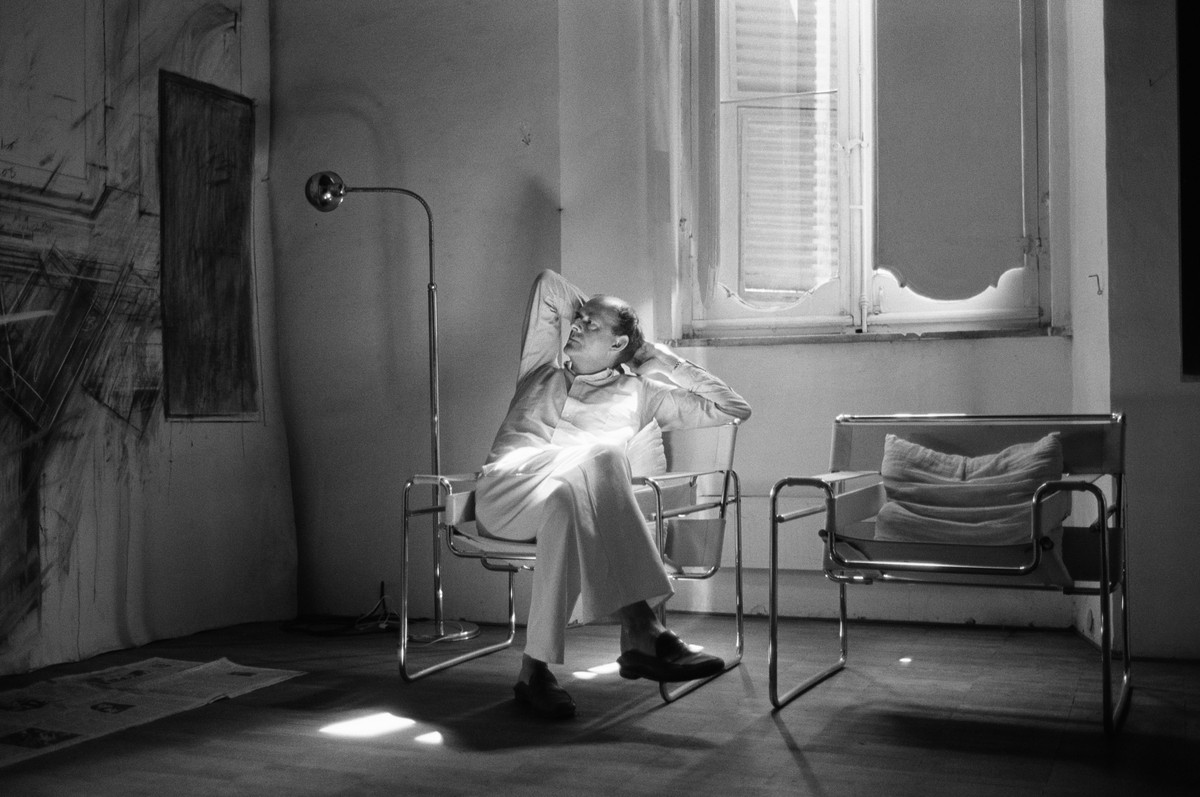
Cy Twombly, Via di Monserrato, Rome, 1978
© Annabelle d’Huart

Cy Twombly, Via di Monserrato, Rome, 1978
© Annabelle d’Huart
Cy Twombly was renowned for artworks integrating cultural, historical, and poetic references—especially to classical antiquity—with abstract forms and his inimitable scrawl. Born Edwin Parker Twombly, Jr. on April 25, 1928 in Lexington, Virginia to Edwin Parker (“Cy”) Twombly, Sr. and Mary Velma Twombly (née Richardson), Twombly received early artistic education from Pierre Daura and Marion Junkin at Washington and Lee University. This was followed by formative education at the Arts Students League of New York and Black Mountain College, where he formed lifelong connections with artists such as Robert Rauschenberg, John Cage, and Merce Cunningham.
However, it was his 1952 voyage to Italy and North Africa with Rauschenberg, funded by a grant from the Virginia Museum of Fine Arts, that proved decisive for Twombly: as he wrote in his fellowship application, he felt “that Modern Art isn't dislocated, but something with roots, tradition and continuity.”[1] Traveling there, Twombly encountered much of the cultural history that grounded his subsequent artistic production and produced notable early works such as his North African Sketchbooks (1953).
Twombly returned to Italy in 1957 and 1958, during which time he mounted his first Italian solo exhibition at the Galleria La Tartaruga of Plinio De Martiis. He also produced several major early works, including Olympia, Arcadia, Blue Room and Sunset (1957). In 1959 in New York, Twombly married Luisa Tatiana Franchetti, a photographer, painter, and collector of rare Indian and Middle Eastern textiles. They returned to Italy, where Twombly lived for at least part of each year for the rest of his life. Their son, Cyrus Alessandro Twombly, was born in December 1959, an occasion marked by Twombly’s monumental Age of Alessandro.
The early 1960s was a productive period for Twombly, who famously spent long periods reading and contemplating before executed paintings in sporadic, frenzied bursts of activity. Major artworks like the series of five Ferragosto (1961) and The Italians (1961) come from this period. In the 1970s, the artist became increasingly disenchanted with life in Rome, a change the artist’s longtime assistant and archivist Nicola Del Roscio attributed to the suicide of their friend Nini Pirandello in 1971. Twombly subsequently spent more time elsewhere in Italy, most notably in Bassano in Teverina in a palazzo he renovated with Giorgio Franchetti. There, he turned to pastoral themes, as in his large triptych Thyrsis (1977). Bassano in Teverina was also where Twombly completed the first of his monumental painting cycles, Fifty Days at Iliam (1978), now permanently installed at the Philadelphia Museum of Art.
The 1980s included influential travel, including to Luxor, Egypt, and saw the artist move within Italy to Gaeta, having been introduced to the seaside town by Del Roscio. He spent the majority of the final two decades of his life there, alternating with returns to Lexington, where he maintained a studio. In the 1990s, Twombly turned more towards monumental works such as Quattro Stagioni (1993-1994) and Untitled (Say Goodbye, Catullus, to the Shores of Asia Minor) (1994), synthesizing several poets and themes from throughout his practice. This scale continued into the early 2000s with the cycles Coronation of Sesostris (2000) and Lepanto (2001), exhibited at the 49th Venice Biennale, where he was awarded the Golden Lion. The final decade of his practice was marked by a focus on Bacchic themes and large-scale floral compositions inscribed with poetry. He died on July 5, 2011 in Rome.
Throughout his career, Twombly pursued a highly individual vision grounded in his vast intellectual engagements and eschewed both the universalizing machismo of Abstract Expressionism and the sleekly industrial nonreferentiality of Minimalism. Instead, he dwelled in his own idiosyncratic imaginary, always operating at an odd angle to the New York art world he left behind. The singularity of his vision was increasingly recognized in later life, and major honors followed. In addition to the Golden Lion and among other distinctions, Twombly was named Chevalier de l’Ordre des Arts et des Lettres (1988), received an honorary doctorate from Washington and Lee University (1993), and was awarded the Praemium Imperiale (1996).
Though famously private, Twombly maintained strong intellectual connections throughout his life with figures ranging from poet Patricia Waters to other artists such as photographer Sally Mann. This intellectual circle also included figures either long dead or fictional through his vast book collecting activity, with decades-long engagements with James Joyce, Rainer Maria Rilke, D.H. Lawrence, Alexander Pope, Homer, and Plato, among others. Conservator Carol Mancusi-Ungaro has noted that Twombly “would speak freely of Don Juan, his mother, and Apollo. It did not seem to matter that they had lived hundreds of years ago or ten years ago, or never lived at all. Each seemed equally available to him.”[2] This mix of present and past intellectual engagements is palpable throughout his practice. With remarkable consistency, Twombly pursued the clear and singular vision articulated in his early fellowship application to the Virginia Museum of Fine Arts: “to establish is that Modern Art isn’t dislocated, but something with roots, tradition and continuity.”[3]
(Text by Jamie Danis)
[1] Cy Twombly, application for Virginia Museum Fellowship, 1952. Box 68, folder 42, RG01.01.1.3211. Director’s Correspondence, Virginia Museum of Fine Arts Archives, Richmond, Virginia.
[2] Carol Mancusi-Ungaro, “Cues from Cy Twombly,” 2013. In Cy Twombly Gallery: The Menil Collection, Houston, edited by Julie Sylvester and Nicola del Roscio, 63. New York: Cy Twombly Foundation; Houston: Menil Foundation.
[3] Cy Twombly, application for Virginia Museum Fellowship, 1952. (cit.)